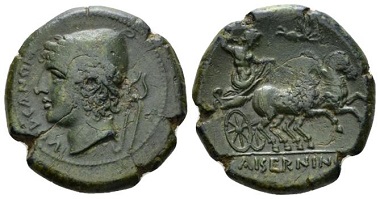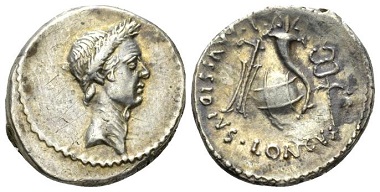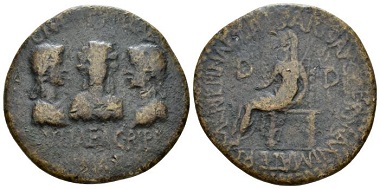15-07-2017 – 01-01-1970
Live Auction 33
Naville Numismatics’ Live Auction 33
Naville Numismatics’ Live Auction 33 features a selection of 558 lots of Greek, Roman, Byzantine coins, all chosen with contribution from NAC’s experts. The auction will close on Sunday 16 July 2017, 16.00 UK time, at which time the live session will begin.
Lot 1: Samnium, Isernia. Bronze, circa 263-240. Good Very Fine. Ex NAC sale 64, 2012, 1982. From the Giancarlo Silingardi collection. Starting bid: £180.
The sale begins with a selection of coins, including bronzes and fractions, from Magna Graecia and Sicily, most of them from the E.E. Clain-Stefanelli Collection sold in association with Stacks Bowers Galleries. This section of the sale includes coins from rare mints such as Isernia, Suessa, Morgantina and Motya and also offers an attractive series of coins from Tarentum, Heraclea, Metapontum, Thurium, Velia, Caulonia, Croton, Syracuse, and Athens, even beyond a selection of Hellenistic portraits of Seleucid and Ptolemaic kings.
Lot 42: Sicily, Syracuse. Corinthian stater, circa 334-317. Extremely Fine. Starting bid: £650.
Highlights include an extremely rare nomos of Tarentum with the oecist seated on rock, a beautiful stater of Syracuse and an extremely rare hecte of Mytilene.
Lot 400: Julius Caesar and L. Mussidius Longus. Denarius, circa 42. About Extremely Fine/Extremely Fine. Starting bid: £700.
The Roman selection boasts an interesting series of Roman Republican bronzes and a striking array of denarii, again most of them from the E.E. Clain-Stefanelli Collection. This includes a rare didrachm, a beautiful quadrigatus, a brilliant denarius of L. Calpurnius Piso Frugi, a rare denarius of C. Egnatius Cn. f. Cn. n. Maxumus, a beautiful denarius of Q. Cassius Longinus, an interesting denarius of L. Hostilius Saserna, depicting Vercingetorix, and a beautiful bronze of Octavian. In this part, there is also an interesting selection of Republican portraits such as Julius Caesar, Marcus Antonius and Octavian.
The Imperial selection of the sale features an attractive series of Augustus as well as an attractive aureus with Caius and Lucius, a beautiful dupondius of Antonia, a rare aureus of Nero Caesar, a rare dupondius of Macrinus, a very rare denarius of Diocletian and a very interesting bronze of Valentinian I, even beyond a selection of denarii, sestertii, dupondii and asses which included Claudius, Nero, Vespasian, Domitian, Trajan, Hadrian, Marcus Aurelius and Commodus.
It is also remarkable a wonderful sestertius, from the E.E. Clain Stefanelli collection, of Nero with the quadriga on triumphal arch on reverse.
Lot 133: Bithynia, Apamea Drusilla, Julia and Agrippina, sisters of Caligula. Bronze, circa 38. About Very Fine. From the E.E. Clain-Stefanelli collection. Starting bid: £900.
The Roman Provincial part of the sale includes a selection from the Dattari Collection.
It is composed of Alexandrine coins from Octavian to Galerius with various types of obols, diobols, hemidrachms, and drachms featuring rare portrayals of ancient divinities.
Highlights include coins of Augustus, Claudius, Domitian, Trajan, Hadrian, Antoninus Pius and Lucius Verus, remarkable specimens both for the state of preservation and rarity.
The Roman Provincial part of the sale includes a selection from the Dattari Collection.
It is composed of Alexandrine coins from Octavian to Galerius with various types of obols, diobols, hemidrachms, and drachms featuring rare portrayals of ancient divinities.
Highlights include coins of Augustus, Claudius, Domitian, Trajan, Hadrian, Antoninus Pius and Lucius Verus, remarkable specimens both for the state of preservation and rarity.
Giovanni Dattari, collector of Alexandrinian coins
Giovanni Dattari was born in Livorno on 19th April 1858 and moved to Egypt with his family after the death of his father in 1875.
He is known to have been a keen and competent amateur-merchant of Egyptian antiquities and Greek and Roman coinage. His study in the family villa in Cairo was a common meeting place for archaeologists, Egyptologists and numismatists.
Dattari started his coin collection in 1891 and by 1894 it was comprised of 395 pieces in base silver and 2207 in bronze.
By 1903 the collection had grown to 6835 Alexandrian, 91 archaic Greek, 230 of Alexander the Great, 910 Ptolemaic, 19320 Roman coins and 630 lead and silver pieces and in the following years this number of coins more than doubled.
His corpus consists of 327 pages (of which four are missing); it begins with a bronze of Augustus and ends with an astonishing quantity of extremely rare issues of Domitianus. Dattari listed all the coins in his collection and reproduced them by pencil tracing over casts.
Giovanni Dattari died in 1923, leaving his wife Eudosia Zifà and his two children, Maria and Marco Aurelio.
Dattari had already donated a substantial number of Alexandrian coins to the Museo Nazionale in Rome in 1920 and after his death the idea of donating his entire collection to the museum was prompted by his daughter Maria who wanted the collection to be made available to the public in a gallery dedicated to her father’s memory.
Naville Numismatics Ltd’s partnership with NAC guarantees highly professional numismatic service and certifies an unlimited warranty of authenticity for the lots it sells.
You may find all offered coins here.
You will find all highlights of the auction gathered on this webpage.
Absentee bidders can bid electronically through Naville Numismatics website from the day the sale is published online up to the start of the live Session.







